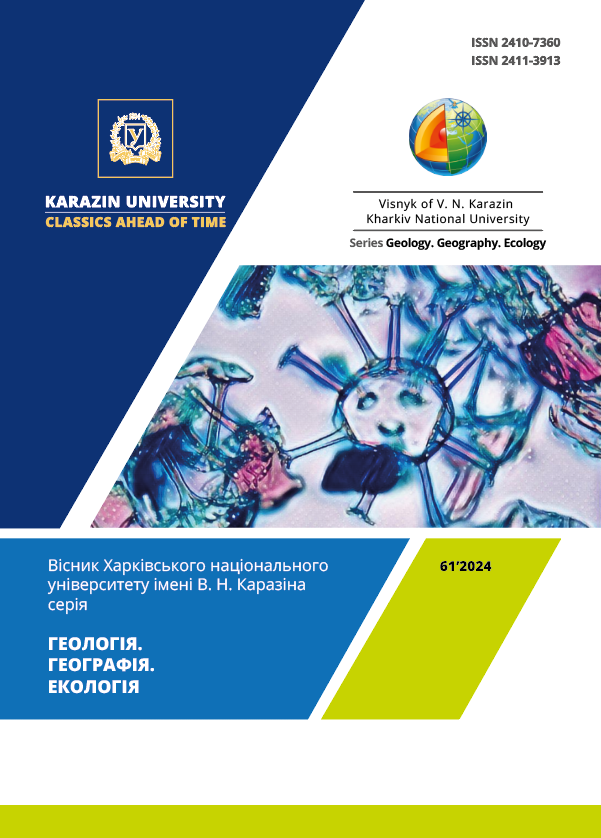Strategic Spatial Planning of Territorial Communities to achieve the Sustainable Development Goals
Abstract
Problem Statement. Strategic spatial planning in Ukraine focuses mainly on economic aspects and takes less into account the environmental consequences of planned activities, which may be threatening to natural and cultural heritage. This is explained, in particular, by the insufficient number of trained specialists for planning sustainable spatial development. It is especially important to integrate scientific natural research into educational programs for training specialists in spatial planning, which include the study of geodiversity, the evolution of natural and cultural landscapes, methods of creating nature conservation areas, the formation of eco-networks, as well as the introduction of innovative technologies in land use and various branches of the national economy. Such research is the basis for developing community strategy and achieving the Sustainable Development Goals (SDGs), effective territorial management and successful spatial planning practices.
The purpose of the article is to consider strategic spatial planning as a modern interdisciplinary field that integrating social, economic, and ecological aspects of sustainable spatial development.
Research methodology proposes an interdisciplinary approach to strategic planning, which takes into account the geodiversity of the territory, the evolution of natural and cultural landscapes, as well as natural and anthropogenic risks. This approach makes it possible to predict optimal scenarios of spatial development, adapted to specific geographical conditions. Special attention is paid to the training of highly qualified specialists at the bachelor's and master's levels, emphasizing their important role in the development of strategic plans, which are the basis of comprehensive plans for the spatial development of territorial communities.
The results. The article presents scientific approaches to strategic planning based on an interdisciplinary study of territories. This study highlights the international experience of strategic planning and similar successful practices in Ukraine territorial communities.
Scientific novelty. The study provides a theoretical basis for the mandatory integration of natural science research into strategic spatial planning. This includes data on geodiversity, natural settings and resources, cultural and natural landscapes, nature reserves and ecological networks. The combination of this information with the data of the land and urban cadasters creates a comprehensive basis for determining the optimal scenarios of spatial development.
Practical significance. The results of this study can be applied to improve the methodology of strategic spatial planning at the local level. Generalized international experience is a valuable guide for setting long-term spatial development goals and implementing specific measures to achieve them. Practical aspects of spatial planning, such as innovative land use systems, implementation of renewable energy sources, inclusive residential and public spaces, protection and preservation of natural and cultural heritage, are illustrated by specific examples discussed in the article. This study is useful for professionals in spatial planning and community management, as well as for researchers, teachers, and students who focus on integrating natural science research into the practice of spatial development.
Downloads
References
Achkasov, A., Popovych, N., Peresadko, V., & Gordeziani, T. (2024). Geoinformation support of geoportals of territorial communities: Pre-war realities and post-war prospects. Visnyk of V. N. Karazin Kharkiv National University, Series "Geology. Geography. Ecology," (60), 124–136. https://doi.org/10.26565/2410-7360-2024-60-09 [in Ukrainian].
All-Ukrainian Association of Communities https://communities.org.ua/about-the-association/
Association of Ukrainian Cities. (n.d.). Retrieved from https://www.auc.org.ua/
Association DANUBEPARKS. (n.d.). Retrieved from https://danubeparks.org/association
Baumgart, A., Vlachopoulou, E. I., Vera, J. D. R., et al. (2021). Space for the Sustainable Development Goals: Mapping the contributions of space-based projects and technologies to the achievement of the 2030 Agenda for Sustainable Development. Sustainability in Earth Systems, 4(6). https://doi.org/10.1186/s42055-021-00045-6
Ministry for Communities and Territories Development of Ukraine https://mtu.gov.ua/en/content/hto-mi-e.html
Mollison, B., & Slay, R. M. (2019). Introduction to permaculture. Permaculture in Ukraine. Retrieved from https://www.permaculture.in.ua/index.php/uk/navchannia-ua/pereklady-knyh-ua/17-books/51-introduction-to-permaculture-ua
Brilha, J. (2016). Inventory and quantitative assessment of geosites and geodiversity sites: A review. Geoheritage, 8(2), 119–134. https://doi.org/10.1007/s12371-014-0139-3
Darby, S., & Sear, D. (2008). River restoration: Managing the uncertainty in restoring physical habitat. Chichester, UK: Wiley.
Designing Child-Friendly Cities. (2024). Retrieved from https://urbandesignlab.in/designing-child-friendly-cities/
Danube Delta Biosphere Reserve. (n.d.). Official website. Retrieved from https://www.dbr.org.ua/search/label/about_ua
European Union. (n.d.). EU Strategy for the Danube Region. Retrieved from https://danube-region.eu/
EIP-AGRI Project Database. (n.d.). Retrieved from https://eu-cap-network.ec.europa.eu/projects_en
Gray, M. (2024). Case studies associated with the 10 major geodiversity-related topics. Philosophical Transactions of the Royal Society A, 382(20230055). https://doi.org/10.1098/rsta.2023.0055
Group on Earth Observations (GEO). (2020). FAQ: What is Earth Observation? Retrieved from https://www.earthobservations.org/g_faq.html
ICOMOS. (2017). Principles for the conservation of rural landscapes as heritage. Retrieved from https://www.icomos.org/images/DOCUMENTS/Charters/GA2017_6-3-1_RuralLandscapesPrinciples_EN_adopted-15122017.pdf
Lausch, A., et al. (2022). Remote sensing of geomorphodiversity linked to biodiversity—Part III: Traits, processes and remote sensing characteristics. Remote Sensing, 14(2279). https://doi.org/10.3390/rs14092279
Kubakh, S. & others. (2022). Development of comprehensive plans: a practical guide for communities. Kyiv, 87. URL : https://decentralization.ua/uploads/library/file/817/ [in Ukrainian].
Kubakh, S. & others. (2022). Strategic environmental assessment of a comprehensive plan: a practical guide. Kyiv, 106. URL : https://decentralization.ua/uploads/library/file/819/SEO_ready.pdf [in Ukrainian].
Mollison, B., & Slay, R. M. (2019). Introduction to permaculture. Retrieved from https://www.permaculture.in.ua/index.php/uk/navchannia-ua/pereklady-knyh-ua/17-books/51-introduction-to-permaculture-ua
National Institute for Research and Development of the Danube Delta (DDNI). (n.d.). Retrieved from http://ddni.ro/wps/
Gallent, N., Hamiduddin, I., Juntti, M., Kidd, S., & Shaw, D. (2015). Introduction to rural planning: Economies, communities and landscapes (2nd ed.). London: Routledge. https://doi.org/10.4324/9781315749280
Ostoja Natury: https://ostojanatury.pl/our-projects/
Popovych, N. V. (2017). Methods of map series production for a local social-economic development strategy (a case study of Pesochin urban village). Problems of Continuous Geographic Education and Cartography: Collected Scientific Works, Kharkiv: Kharkiv National University, (25), 45–49. Retrieved from https://periodicals.karazin.ua/pbgok/article/view/9089 [in Ukrainian].
Solar_Greenhouse. (2020). Effect of North Wall Materials on the Thermal Environment in Chinese Solar Greenhouse. Retrieved from https://www.researchgate.net/publication/338359854
Smart Rural 21 Project. (n.d.). Retrieved from https://www.smartrural21.eu/villages/
Sustainable Development Report. (2024). Retrieved from https://files.unsdsn.org/sustainable-development-report-2024.pdf
United Nations Office for Outer Space Affairs (UNOOSA). (n.d.). Space Supporting the Sustainable Development Goals. Retrieved from https://www.unoosa.org/oosa/en/ourwork/space4sdgs/index.html
United Nations. (2015). Transforming our world: The 2030 Agenda for Sustainable Development. Retrieved from https://sdgs.un.org/goals
United States Agency for International Development (USAID) Agriculture and Rural Development Program (AGRO) https://www.usaid.gov/uk/ukraine/economic-growth
Wood100. (n.d.). Wood is 100% wood. Retrieved from https://www.thoma.at/en/
Law of Ukraine “On National Geospatial Data Infrastructure”. Available at: https://zakon.rada.gov.ua/laws/show/554-20#Text

This work is licensed under a Creative Commons Attribution 4.0 International License.





